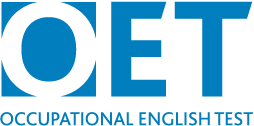Occupational English Test
Occupational English Test (OET) is an international English language test that assesses the language communication skills of healthcare professionals who seek to register and practise in an English-speaking environment. OET is available for 12 professions, including medicine, nursing, dentistry, pharmacy, physiotherapy, veterinary science, occupational therapy, speech pathology, dietetics, podiatry, radiography, and optometry.
History[edit | edit source]
The Occupational English Test was developed in the late 1980s by Professor Tim McNamara, under the auspices of the Australian National Office for Overseas Skills Recognition (NOOSR), which is now part of the Department of Education, Skills and Employment (DESE). The aim was to create a test that would provide a valid and reliable assessment of the English language proficiency of healthcare professionals. Since its inception, OET has undergone several revisions to ensure it remains relevant to the current healthcare industry and its language requirements.
Format[edit | edit source]
OET covers all four language skills with an emphasis on communication in a healthcare environment. The test consists of four components:
- Listening (approximately 45 minutes) - divided into three parts, designed to assess the ability to follow and understand a range of health-related spoken materials such as patient consultations and lectures.
- Reading (60 minutes) - divided into two parts, testing the ability to read and understand different types of text on health-related subjects.
- Writing (45 minutes) - consists of one task specific to the profession, based on typical workplace situations.
- Speaking (approximately 20 minutes) - also profession-specific, involves two role-plays in which the test-taker assumes their professional role and interacts with a patient or client.
Recognition[edit | edit source]
OET is recognized by regulatory healthcare bodies and councils in various countries including Australia, New Zealand, United Kingdom, Ireland, Dubai, Singapore, and others. It is also accepted by universities and a wide range of healthcare employers as proof of English proficiency for registration, study, and work in the healthcare sector.
Preparation and Registration[edit | edit source]
Candidates can prepare for OET by accessing a range of materials and courses provided by the OET Centre and accredited preparation providers. Registration for the test can be done through the official OET website, where candidates can choose their profession, select a test date, and find a test venue near them.
Benefits[edit | edit source]
For healthcare professionals, passing OET demonstrates they have the necessary language skills to communicate effectively in a healthcare environment, ensuring safe and high-quality patient care. For employers and regulatory bodies, it provides assurance that the healthcare professionals they register or employ can communicate effectively, which is critical for patient safety and care.
Transform your life with W8MD's budget GLP1 injections from $125
W8MD offers a medical weight loss program NYC and a clinic to lose weight in Philadelphia. Our W8MD's physician supervised medical weight loss centers in NYC provides expert medical guidance, and offers telemedicine options for convenience.
Why choose W8MD?
- Comprehensive care with FDA-approved weight loss medications including:
- loss injections in NYC both generic and brand names:
- weight loss medications including Phentermine, Qsymia, Diethylpropion etc.
- Accept most insurances for visits or discounted self pay cost.
- Generic weight loss injections starting from just $125.00 for the starting dose
- In person weight loss NYC and telemedicine medical weight loss options in New York city available
- Budget GLP1 weight loss injections in NYC starting from $125.00 biweekly with insurance!
Book Your Appointment
Start your NYC weight loss journey today at our NYC medical weight loss, and Philadelphia medical weight loss Call (718)946-5500 for NY and 215 676 2334 for PA
Search WikiMD
Ad.Tired of being Overweight? Try W8MD's NYC physician weight loss.
Semaglutide (Ozempic / Wegovy and Tirzepatide (Mounjaro / Zepbound) available. Call 718 946 5500.
Advertise on WikiMD
|
WikiMD's Wellness Encyclopedia |
| Let Food Be Thy Medicine Medicine Thy Food - Hippocrates |
Translate this page: - East Asian
中文,
日本,
한국어,
South Asian
हिन्दी,
தமிழ்,
తెలుగు,
Urdu,
ಕನ್ನಡ,
Southeast Asian
Indonesian,
Vietnamese,
Thai,
မြန်မာဘာသာ,
বাংলা
European
español,
Deutsch,
français,
Greek,
português do Brasil,
polski,
română,
русский,
Nederlands,
norsk,
svenska,
suomi,
Italian
Middle Eastern & African
عربى,
Turkish,
Persian,
Hebrew,
Afrikaans,
isiZulu,
Kiswahili,
Other
Bulgarian,
Hungarian,
Czech,
Swedish,
മലയാളം,
मराठी,
ਪੰਜਾਬੀ,
ગુજરાતી,
Portuguese,
Ukrainian
Medical Disclaimer: WikiMD is not a substitute for professional medical advice. The information on WikiMD is provided as an information resource only, may be incorrect, outdated or misleading, and is not to be used or relied on for any diagnostic or treatment purposes. Please consult your health care provider before making any healthcare decisions or for guidance about a specific medical condition. WikiMD expressly disclaims responsibility, and shall have no liability, for any damages, loss, injury, or liability whatsoever suffered as a result of your reliance on the information contained in this site. By visiting this site you agree to the foregoing terms and conditions, which may from time to time be changed or supplemented by WikiMD. If you do not agree to the foregoing terms and conditions, you should not enter or use this site. See full disclaimer.
Credits:Most images are courtesy of Wikimedia commons, and templates, categories Wikipedia, licensed under CC BY SA or similar.
Contributors: Prab R. Tumpati, MD



